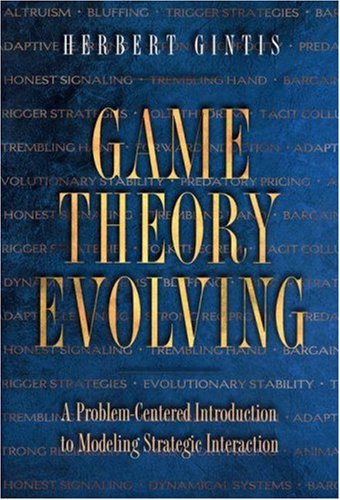
Sinossi
This revised edition contains new material & shows students how to apply game theory to model human behaviour in ways that reflect the special nature of sociality & individuality. It continues its in-depth look at cooperation in teams, agent-based simulations, experimental economics, & the evolution & diffusion of preferences.
Le informazioni nella sezione "Riassunto" possono far riferimento a edizioni diverse di questo titolo.
Dalla quarta di copertina
"Mathematically rigorous, computationally adroit, rich in illuminating problems, and engagingly written, Game Theory Evolving will be invaluable to students and researchers across the social sciences."--Joshua M. Epstein, The Brookings Institution and Santa Fe Institute
"Herb Gintis weaves classical game theory together with recent work in experimental economics, biology, evolutionary game theory, and behavioral economics. His book has something new, possibly something to argue with, but always something intriguing, for everyone."--Larry Samuelson, University of Wisconsin
"For anyone interested in game theory as a conceptual framework for investigating and thinking about strategic behavior in the social world, broadly interpreted, this book is a must reference work. Herb Gintis is to be congratulated for integrating a large literature on theory, evolution, experimental and field observations into an accessible treatise."--Vernon Smith,University of Arizona
"There is a great need for a problem book in game theory, and Gintis is correct to emphasize that learning game theory requires the solving of problems."--Michael Suk-Young Chwe, New York University
"Simply to have all this material in one place is refreshing and a big step forward. Gintis is careful on technical detail and clearly loves these models."--Colin Camerer,California Institute of Technology
"Game Theory Evolving is the most up-to-date textbook in game theory on the market. Gintis covers an extraordinary range of topics, including some of the most recent developments in theory, with both stylistic verve and mathematical rigor. More importantly, he shows how the theory illuminates a great variety of real-world situations that both students and professors can relate to."---H. Peyton Young, The Johns Hopkins University and The Brookings Institution
Dal risvolto di copertina interno
"Mathematically rigorous, computationally adroit, rich in illuminating problems, and engagingly written, Game Theory Evolving will be invaluable to students and researchers across the social sciences."--Joshua M. Epstein, The Brookings Institution and Santa Fe Institute
"Herb Gintis weaves classical game theory together with recent work in experimental economics, biology, evolutionary game theory, and behavioral economics. His book has something new, possibly something to argue with, but always something intriguing, for everyone."--Larry Samuelson, University of Wisconsin
"For anyone interested in game theory as a conceptual framework for investigating and thinking about strategic behavior in the social world, broadly interpreted, this book is a must reference work. Herb Gintis is to be congratulated for integrating a large literature on theory, evolution, experimental and field observations into an accessible treatise."--Vernon Smith,University of Arizona
"There is a great need for a problem book in game theory, and Gintis is correct to emphasize that learning game theory requires the solving of problems."--Michael Suk-Young Chwe, New York University
"Simply to have all this material in one place is refreshing and a big step forward. Gintis is careful on technical detail and clearly loves these models."--Colin Camerer,California Institute of Technology
"Game Theory Evolving is the most up-to-date textbook in game theory on the market. Gintis covers an extraordinary range of topics, including some of the most recent developments in theory, with both stylistic verve and mathematical rigor. More importantly, he shows how the theory illuminates a great variety of real-world situations that both students and professors can relate to."---H. Peyton Young, The Johns Hopkins University and The Brookings Institution
Le informazioni nella sezione "Su questo libro" possono far riferimento a edizioni diverse di questo titolo.
Altre edizioni note dello stesso titolo
Risultati della ricerca per Game Theory Evolving: A Problem-Centered Introduction...
Game Theory Evolving
Da: Grey Matter Books, Hadley, MA, U.S.A.
Hardcover. Condizione: Very Good. Condizione sovraccoperta: Very Good. Pencil notes and underlining found in the introduction; the rest of the text appears unmarked. Pages are bright. Binding is sturdy. Dust jacket is lightly edge worn. International/Priority shipping at cost. Codice articolo 071845
Compra usato
Quantità: 1 disponibili

